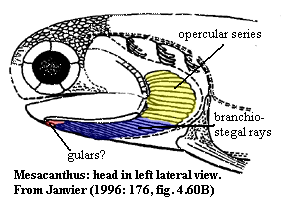|
|
Bones: Dermal Bones |
| Vertebrates |
Mandibular Series:
Gulars |
The Mandibular Series: Gulars
 The gulars are restricted to various fish groups and are not terribly interesting bones in themselves. They would not normally be worth much attention. However, they do provide an occasion to add a rarely noticed footnote to the jaw story which, as frequently remarked elsewhere, is the central plot in our tale of the vertebrate skull.
The gulars are restricted to various fish groups and are not terribly interesting bones in themselves. They would not normally be worth much attention. However, they do provide an occasion to add a rarely noticed footnote to the jaw story which, as frequently remarked elsewhere, is the central plot in our tale of the vertebrate skull.
The gular is defined in Fishbase as a "median, dermal bone between the dentary bones of some primitive fishes (e.g. Latimeria and Elops)." As has been our general rule with bones with this kind of phylogenetic distribution, we will define the Standard Condition with reference to Cheirolepis. For once, there seems not to be any reason to suspect that the actinopterygian and sarcopterygian versions of this bone are independently derived.
From the figure, it is almost painfully obvious that the gulars are serially homologous with the branchiostegal rays -- the series of dermal bones that provide the flexible bone floor to the mouth in many different fish lineages. What is less often remarked is that the same relationship holds for the  opercular series. The acanthodian Mesacanthus (see figure) shows this relationship well. This complete continuity between the opercular and branchiostegal series is also present in Mimia; and even the highly derived dipnoan, Griphognathus, suggests the same relationship. We can even follow the trail of supposition a little further out and remark on the similarity to the infradentary series, just lateral to the branchiostegal series, which was discussed in connection with the derivation of the surangular, and perhaps even the splenials on the inside of the jaw.
opercular series. The acanthodian Mesacanthus (see figure) shows this relationship well. This complete continuity between the opercular and branchiostegal series is also present in Mimia; and even the highly derived dipnoan, Griphognathus, suggests the same relationship. We can even follow the trail of supposition a little further out and remark on the similarity to the infradentary series, just lateral to the branchiostegal series, which was discussed in connection with the derivation of the surangular, and perhaps even the splenials on the inside of the jaw.
What this all suggests is that there may be a common derivation for structures as diverse as the opercular, the surangular and the gular. All of these seem to have evolved from serial repetition of a simple laminar pattern of small dermal plates running along the outside of the "mandibular arch."
ATW011207.
Note added in proof: more than eight years after this page was first written it now seems to be generally accepted that the gulars are simply the most anterior extension of an "opercular-gular" system. The extension of this system under the jaw turns out to have been present in Onychodus after all, as well as in Psarolepis and Guiyu. Zhu et al. (2009). We have accordingly deleted an earlier note expressing doubt about our original position. ATW090328.
checked ATW090328
modified ATW090328
 The gulars are restricted to various fish groups and are not terribly interesting bones in themselves. They would not normally be worth much attention. However, they do provide an occasion to add a rarely noticed footnote to the jaw story which, as frequently remarked elsewhere, is the central plot in our tale of the vertebrate skull.
The gulars are restricted to various fish groups and are not terribly interesting bones in themselves. They would not normally be worth much attention. However, they do provide an occasion to add a rarely noticed footnote to the jaw story which, as frequently remarked elsewhere, is the central plot in our tale of the vertebrate skull. opercular series. The
opercular series. The